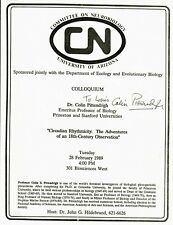"Circadian Clock" Colin Pittendrigh Signed Announcement Dated 1989 Mueller COA For Sale

When you click on links to various merchants on this site and make a purchase, this can result in this site earning a commission. Affiliate programs and affiliations include, but are not limited to, the eBay Partner Network.
"Circadian Clock" Colin Pittendrigh Signed Announcement Dated 1989 Mueller COA:
$279.99
Up for sale a RARE!"Circadian Clock" Colin Pittendrigh Hand Signed Announcement Dated 1989.This item is certified authentic by ToddMueller Autographs and comes with their Certificate ofAuthenticity.ES-2762Colin Stephenson Pittendrigh (October 13, 1918 – March 19, 1996) was a British-born biologist who spent most of his adult life in the United States. Pittendrigh is regarded as the "father of the biological clock," and founded the modern field of chronobiology alongside Jürgen Aschoff and Erwin Bünning. He is known for his careful descriptions of the properties of the circadian clock in Drosophila and other species, and providing the first formal models of how circadian rhythms entrain (synchronize) to local light-dark cycles. He obtained his botany degree from the University of Durham (King's College) in 1940. Assigned to wartime service as a biologist in Trinidad during World War II, he studied malaria transmission by mosquitoes. After the war, he attended Columbia University to study for his Ph.D. He later joined the faculty of Princeton University and started his chronobiology research. He also co-chaired a Mars exploration project at NASA from 1964 to 1966. The defining principle that Pittendrigh developed throughout his career was that the properties of the circadian clock are independent from those of the behaviors it controls. This gave him the freedom to study the clock through a range of physiological functions from the hatching of fruit flies to rodents' locomotor activities. He performed large series of experiments to demonstrate that circadian rhythmicity is intrinsic and independent of environmental cues. He carried out a famous and protracted debate with Frank Brown, of Northwestern University, on whether circadian timekeeping is intrinsic or environmentally driven. Pittendrigh's data and argument ultimately prevailed and sparked interest in chronobiology. Pittendrigh died from cancer on Tuesday, March 19, 1996, at his home in Bozeman, Montana. He has been regarded as one of the most influential figures in the field, and his research influences the field of chronobiology even after his death. The Society for Research on Biological Rhythms holds biennial lectures named in honor of Pittendrigh and Aschoff. Colin Pittendrigh was born in Whitley Bay, on the coast of [[Northumberland] (today Tyne and Wear) on October 13, 1918. He received his first degree in botany in 1940 from University of Durham, now University of Newcastle upon Tyne. Pittendrigh was a conscientious objector and so during World War II, he was assigned to wartime service to try and improve the production of bananas and other fruit that was being shipped to the UK during the war. He also worked as a biologist for the Rockefeller Foundation and the government of Trinidad to control malaria near the military bases there. He studied the epidemiology of malaria transmitted by mosquitoes breeding in epiphytic bromeliad ("tanks" formed by overlapping leaves) in the forest canopy. He made acute observations on bromeliad distribution within forest canopies and between contrasting forest formations. He observed daily rhythms in mosquito activity patterns, particularly noting that peak activity times were different for different species at different canopy levels. His work with the biting rhythms of these mosquitoes was responsible for the development of his interest in biological rhythms, which later led to his experimental studies on eclosion rhythm in Drosophila. After the war, Pittendrigh attended Columbia University to study for his Ph.D. under the evolutionary geneticist Theodosius Dobzhansky. When he finished at Columbia in 1947, he joined the faculty at Princeton, as an assistant professor of biology where he began his work concerning circadian rhythms. While at Princeton, he gained his U.S. citizenship in 1950 and served as dean of graduate studies from 1965 to 1969. Pittendrigh also served on a variety of national scientific boards including the Science Advisory Committee to the Administrator of the National Aeronautics and Space Administration (NASA). In 1969 Pittendrigh left Princeton to join the faculty of Stanford where he helped found the program in Human Biology and later became the director of the Hopkins Marine Station. While serving as the director of the Hopkins Marine Station in 1976-1984, Pittendrigh is credited with helping to rebuild Stanford's century-old marine biology laboratory, bringing in modern molecular biology, ecology and biomechanics, and turning the station into an internationally famous and vigorous one." Pittendrigh retired from Stanford in 1984 and moved to Bozeman, Montana. Here, he continued his studies of biological clocks, working with the faculty and lecturing at Montana State University – Bozeman. Pittendrigh met Aschoff in 1958 when Aschoff made his first visit to the United States. Pittendrigh studied the eclosion rate of fruit flies, while Aschoff studied the continuous circadian rhythm of birds, mammals, and humans. They reached two different conclusions of the entrainment model with Aschoff supporting a parametric entrainment concept (gradual entrainment throughout the day) and Pittendrigh supported a nonparametric entrainment concept (entrainment is sudden and once a day). Despite opposing views, Aschoff and Pittendrigh remained close friends, and they had a lifelong intense exchange of notes and ideas.Their research was described by Serge Daan as "always in harmony, never in synchrony." Pittendrigh was influential in establishing many of the key criteria that a biological system must have in order to be considered a biological clock. His work studying the eclosion (the process of an insect emerging from its pupa stage) rhythms of Drosophila pseudoobscura demonstrated that 1) eclosion rhythms persist without environmental cues (i.e. in constant conditions), 2) unlike most chemical reactions, the period of eclosion remains relatively constant when exposed to changes in ambient temperature ("temperature compensation"), and 3) eclosion rhythms can be entrained by light cycles that are close to the flies' natural period (τ). Beginning in 1958, Pittendrigh developed the concept of the phase response curve or PRC. The PRC allowed chronobiologists to predict how a biological system would be affected by a change in its light schedule. The PRCs, detected almost simultaneously in Pittendrigh's and Woody Hastings' labs, served as the basis for the nonparametric entrainment model that was soon after proposed by Pittendrigh. This nonparametric model of entrainment predicted that the difference between an environmental period (T) and an organism's intrinsic period (τ) is instantaneously corrected every day when light falls at a particular phase (φ) of the cycle where a phase shift (Δφ) equal to this difference is generated. This is reflected through the expression: Δφ(φ)= τ - T. While the PRC has been invaluable towards understanding entrainment, there are several notable problems with the model. The PRC, while accurate at describing Drosophila eclosion rhythms, has trouble predicting various aspects of mammalian entrainment. Compressing subjective day or night intervals in mammals leads to changes in activity that are not predicted by the PRC. It was later shown that these differences are partially due to τ and the PRC being malleable entities modifiable through entrainment. Pittendrigh himself recognized that his model of entrainment was based on simplification and could not accurately model all cases of entrainment. However, this model has been salient in furthering our understanding of entrainment and is widely used today to teach the concept of nonparametric entrainment. Pittendrigh's close friend, Aschoff, proposed a contrasting parametric model of entrainment in which he proposed that light either lengthened or shortened the endogenous period (τ) while also changing the baseline of oscillation. This parametric model suggested that light may affect the period of circadian oscillation and modify the shape – or waveform – and the level around which the oscillation moved. While Aschoff's continuous model of entrainment has largely fallen to the wayside, it is important to remember that Aschoff's contributions helped to address and explain shortcomings in Pittendrigh's nonparametric entrainment model, which is now widely taught and accepted.

Related Items:
"Circadian Clock" Colin Pittendrigh Hand Signed Announcement Dated 1989
$399.99
25 Hour LED Xtraour Digital Clock AM PM Desk Table Extra Hour - Circadian Co
$225.00


